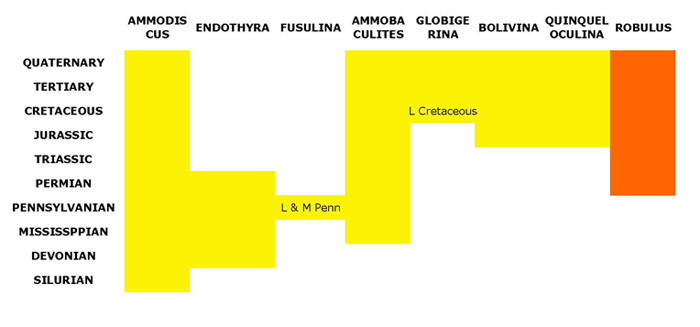What is a fossil?
Preservation of Fossils
Classification and Nomenclature
Stromatolites
question 1, page 101
Replacement
question 2, page 101
The animals in the lower layers were buried in their living position.
The remains of those in the upper layer were reworked in a high energy environment
question 3, page 101
Because such a subdivision would not take into account the diversity of all living things, particularly bacteria.
question 4, page 101
- In a shale.
- Because a shale is not permeable to water. As a consequence, the chemical weathering action of water would be absent or greatly reduced.
question 5, page 101
Because in general there are (and have been) more organisms that live in the ocean, and the ocean offers better conditions for the preservation of their remains. On land, oxygen is readily available and deposits are quickly eroded, if they occur at all. In marine environment, erosion is more uncommon and levels of oxygen are lower.
question 6, page 101
The remains of cyanobacteria with fossil stromatolites indicate photosynthesis, and hence a shallow, well-lighted part of the sea
question 7, page 102
By releasing oxygen in the atmosphere, stromatolites modified the composition of Earth's original atmosphere
question 8, page 102
skipped
Fossils and Living Protists
question 1, page 103
If your limestone is well-indurated or even recrystallized, the original coccoliths structure would be lost
question 2, page 103
Simply label the four fossils in Figure 10.7, page 103
question 3, page 103
Because at great depth in the ocean, specifically below the C.C.D., the cold temperatures and the high water pressure increase the amount of carbon dioxide dissolved in the ocean. Higher amounts of CO2 favor the formation of carbonic acid, which will dissolve calcite, which is the component of coccoliths skeletons.
CaCO3 + H20 + CO2 = Ca2+ + 2HCO3-
question 4, page 103
2.5 micrometers (1 micrometer equals 0.001 mm, see page 102, "Coccolithophores")
question 5, page 104
Lower- to Mid-Triassic (see Coccolith's range in Figure 10.5, page 98)
Diatoms
question 1, page 104
- Diatoms are made of silica, SiO2, which is essentially a glass.
- The small size of diatoms make for an excellent particle and organisms filter. Even most bacteria are too big to be able to move through the spaces that exist between whole or broken tests in a siliceous ooze.
Receptaculids
Foraminiferida
question 3, page 108
- Benthonic: living at the bottom they would indicate that particular environment. A planktonic organism can live everywhere in the ocean there are the right conditions, but upon death it will sink wherever it is, in shallow or deep waters; as a consequence, its presence gives us information about the surface waters environment, but not about the depth of the ocean at that location.
- An oil geologist need to know about the facies and the environment of deposition of rocks that could potentially yield petroleum.
question 4, page 108
Planktonic foraminifera would have a potentially global distribution, while benthonic foraminifera would be endemic to a small portion of the ocean bottom.
question 5, page 108
650 m (or, if you did not want to convert, 65,000 cm)
question 7, page 109
You should show the ranges of all seven genera as listed in question 7a (in yellow in the figure below) AND of Robulus as indicated in question 7b (in orange in the figure below)

- There is no single interval where Endothyra appears by itself. As such, there is no range at all.
(If you only consider the range of Endothyra, it extends from the Devonian to the Permian (see Figure 10.11, page 106). But that is not what the question is asking.)
- Permian
- You can increase the resolution on your age determination.
-
- Fusulina by far
- Because Fusulina is limited to the Lower and Middle Pennsylvanian, while Ammodiscus showed up in the Silurian and it still is around today.
Radiolaria
question 1, page 110
Such a stratum would have to be deposited in an area where radiolarians remains can be preserved after settling. The reasons why foraminifera mightn't be found can include a low surface productivity (but then why do we have radiolarians?) or, more likely, a deep marine environment, below CCD, where foraminifera test, made of calcium carbonate, would dissolve.
question 2, page 110
Because radiolarians tests are often delicate, with a lot of protuberances and filigreed ornamentations. Foraminifera are bulkier and more compact, with less ornamentations.
Back to Top | Back to Labs | Back to Home Page
© Alessandro Grippo, since 1994
Los Angeles, California 
